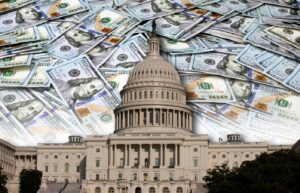- The Mexican Peso holds gains ahead of Wednesday’s “Big Beautiful” tax bill vote.
- The direction of the US Dollar and developments out of the United States remain dominant factors influencing the USD/MXN exchange rate.
- USD/MXN remains under pressure, with prices hovering near seven-month lows.
The Mexican Peso (MXN) is holding firm against the US Dollar (USD) on Tuesday after reaching a fresh year-to-date high in the early hours of the European session as markets turn cautious ahead of Wednesday’s House vote on President Trump’s “One Big Beautiful Bill.”
The legislative uncertainty surrounding the proposed tax package weighs on the USD, with investors assessing its potential implications for US fiscal policy and debt levels.
As the market responds, USD/MXN has slipped by 0.20%, trading below the pivotal level of 19.30 at the time of writing.
Mexican Peso daily digest: USD/MXN remains at the mercy of the Greenback
- As the US Dollar drives broader market direction, shifts in USD sentiment, driven by US fiscal policy, economic data, or Fed signals, tend to dictate the short-term trajectory of USD/MXN, with the Peso reacting accordingly.
- The House will vote on President Trump’s “One Big Beautiful Bill,” which aims to extend the 2017 Tax Cuts and Jobs Act and introduce new tax relief measures.
- While the bill could boost short-term growth, it is projected to increase the federal deficit significantly over the next decade, raising concerns about long-term US debt sustainability and putting pressure on the US Dollar.
- Throughout the day, Fed officials Thomas Barkin, Alberto Musalem, Adriana Kugler, Raphael Bostic, Mary Daly, and Beth Hammack are scheduled to speak, with markets closely watching their remarks for clues on the Fed’s policy outlook amid fiscal and economic uncertainty.
- On Friday, Moody’s became the latest credit agency to downgrade the US sovereign rating.
- As perceived credit risk rises, the US must offer higher interest rates to attract investors who might otherwise shift capital to alternative safe-haven assets.
- On Wednesday, Mexico will release its March retail sales data, while on Thursday, the country will release the first half-month inflation for May and the Gross Domestic Product (GDP) data for the first quarter.
- On the US side, S&P Global will release the preliminary Purchasing Managers Index (PMIs) for May and Existing Home Sales data for April on Thursday for fresh economic signals.
- In short, the USD/MXN pair is sensitive to data that reshapes expectations for growth, inflation, and central bank direction in either country.
Mexican Peso technical analysis: Peso steadies with USD/MXN below 19.30
The USD/MXN has dropped to its lowest level since October, breaking through the previous psychological support level, which has now turned into resistance at 19.30.
Currently, prices are below the descending trendline established during the decline in April.
The Relative Strength Index (RSI) indicator at 36 shows an increase in bearish momentum. Since the 30 mark is considered a potential oversold territory, the bearish trend remains intact, with the next key support level at the round number of 19.20.
USD/MXN daily chart
If prices fall below 19.20, it could open the door to the October low of around 19.11, paving the way towards the 19.00 mark.
On the other hand, if USD strength resurges and prices rise above the descending trendline, USD/XN could see a retest of the April low near 19.47, bringing the 20-day Simple Moving Average (SMA) into play at 19.53.
US Dollar FAQs
The US Dollar (USD) is the official currency of the United States of America, and the ‘de facto’ currency of a significant number of other countries where it is found in circulation alongside local notes. It is the most heavily traded currency in the world, accounting for over 88% of all global foreign exchange turnover, or an average of $6.6 trillion in transactions per day, according to data from 2022.
Following the second world war, the USD took over from the British Pound as the world’s reserve currency. For most of its history, the US Dollar was backed by Gold, until the Bretton Woods Agreement in 1971 when the Gold Standard went away.
The most important single factor impacting on the value of the US Dollar is monetary policy, which is shaped by the Federal Reserve (Fed). The Fed has two mandates: to achieve price stability (control inflation) and foster full employment. Its primary tool to achieve these two goals is by adjusting interest rates.
When prices are rising too quickly and inflation is above the Fed’s 2% target, the Fed will raise rates, which helps the USD value. When inflation falls below 2% or the Unemployment Rate is too high, the Fed may lower interest rates, which weighs on the Greenback.
In extreme situations, the Federal Reserve can also print more Dollars and enact quantitative easing (QE). QE is the process by which the Fed substantially increases the flow of credit in a stuck financial system.
It is a non-standard policy measure used when credit has dried up because banks will not lend to each other (out of the fear of counterparty default). It is a last resort when simply lowering interest rates is unlikely to achieve the necessary result. It was the Fed’s weapon of choice to combat the credit crunch that occurred during the Great Financial Crisis in 2008. It involves the Fed printing more Dollars and using them to buy US government bonds predominantly from financial institutions. QE usually leads to a weaker US Dollar.
Quantitative tightening (QT) is the reverse process whereby the Federal Reserve stops buying bonds from financial institutions and does not reinvest the principal from the bonds it holds maturing in new purchases. It is usually positive for the US Dollar.
Read the full article here
















